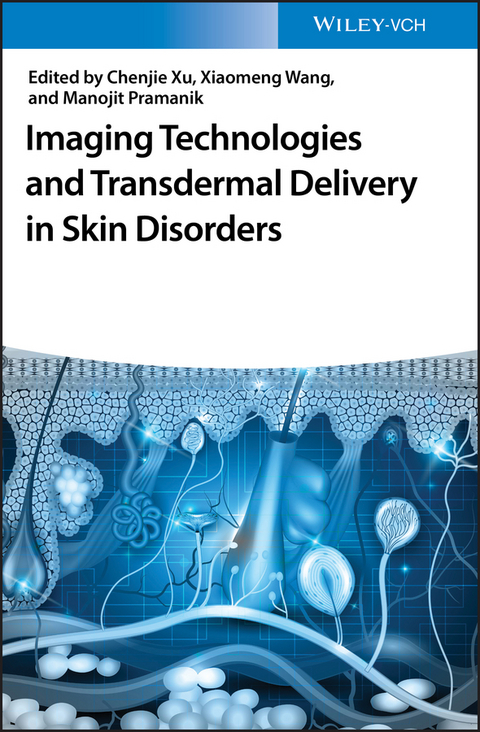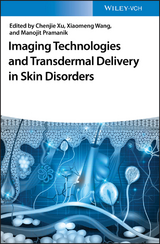Imaging Technologies and Transdermal Delivery in Skin Disorders
Wiley-VCH (Verlag)
978-3-527-34460-4 (ISBN)
- Titel ist leider vergriffen;
keine Neuauflage - Artikel merken
Dr. Chenjie Xu is an assistant professor at School of Chemical and Biomedical Engineering (SCBE) at Nanyang Technological University (NTU), Singapore. He received his PhD. (2009) from Brown University under Prof. Shouheng Sun and did his postdoc under Prof. Jeffrey Karp at Brigham and Women's Hospital. He is interested in developing transdermal technologies for diagnosis and treatment of skin diseases especially abnormal scar. He has published more than 90 peer-reviewed articles. Dr. Xiaomeng Wang currently serves as an Assistant Professor at NTU, Principal Investigator at IMCB, Honorary Lecturer at UCL, Adjunct Research Scientist at SERI. She is an innovative scientist with extensive expertise in the field of vascular biology pertaining to diseases of the skin. Her recent study led to the identification of a novel angiogenic factor, LRG1 and the LRG1 blocking antibody is currently in Phase I clinical trial as a combined treatment strategy with Lucentis in patients with neovascular AMD. Her current research focuses on the role of LRG1 in fibrovascular proliferation and scaring of the skin and her work had been published in high impact journals including Nature and Nature protocols. Over the last few years, her laboratory has established and developed a number of state-of-the-art in vitro, ex vivo, in vivo assay systems that are suitable for detailed characterization of the temporal and spatial interactions between different types of cells involved in sprouting angiogenesis and tissue fibrosis. Dr. Wang is also the co-inventor on two international patents relating to LRG1 and its potential as therapeutic target for vasoproliferative conditions and cancer Dr. Manojit Pramanik received his Ph.D. degree (2010) in Biomedical Engineering from Washington University in St. Louis, St. Louis, USA under the tutelage of Dr. Lihong Wang. He joined the School of Chemical and Biomedical Engineering (SCBE) at Nanyang Technological University (NTU), Singapore as Assistant Professor in January 2014. He obtained his masters (M.Tech.) degree from Department of Instrumentation at Indian Institute of Science (IISc), Bangalore, India in 2004. He did his undergraduate (B.Tech) from the Department of Electrical Engineering at Indian Institute of Technology (IIT), Kharagpur, India in 2002. Prior to joining NTU he served as Assistant Professor in the Department of Electrical Engineering at Indian Institute of Science (IISc), Bangalore, India for one and half years. His industry experiences include two years at General Electric Global Research (GRC), Bangalore, India and one year at Philips Medical System, Bangalore, India. He is the recipient of Department of Atomic Energy (DAE), Government of India Young Scientist Research Award 2013. His research interest include development of photoacoustic and thermoacoustic imaging systems, image reconstruction methods, clinical application areas such as breast cancer imaging, molecular imaging, contrast agent development, monte-carlo simulation for light transport in biological tissue etc. He has more than 100 international journal and conference publications and presentations.
CHAPTER 1: SKIN STRUCTURE AND BIOLOGY
CHAPTER 2: WOUND HEALING AND ITS IMAGING
CHAPTER 3: COMMON SKIN DISEASES - CHRONIC INFLAMMATORY AND AUTOIMMUNE DISORDERS
CHAPTER 4: COMMON SKIN DISEASES - AUTOIMMUNE BLISTERING DISORDERS
CHAPTER 5: COMMON SKIN DISEASES -SKIN CANCER
CHAPTER 6: PRECLINICAL MODELS FOR DRUG SCREENING AND TARGET VALIDATION
CHAPTER 7: SKIN TISSUE ENGINEERING WITH NANOSTRUCTURED MATERIALS
CHAPTER 8: TOPICAL/TRANSDERMAL DELIVERY WITH CHEMICAL ENHANCERS AND NANOPARTICLES
CHAPTER 9: NEEDLE FREE JET INJECTORS FOR DERMAL AND TRANSDERMAL DELIVERY OF ACTIVES
CHAPTER 10: MICRONEEDLES FOR TRANSDERMAL DRUG DELIVERY
CHAPTER 11: ULTRASOUND ENHANCED TRANSDERMAL DRUG DELIVERY
CHAPTER 12: IONTOPHORESIS ENHANCED TRANSDERMAL DRUG DELIVERY
CHAPTER 13: ULTROSOUND IMAGING IN DERMATOLOGY
CHAPTER 14: QUANTITATIVE MAGNETIC RESONANCE IMAGING OF THE SKIN: IN VITRO AND IN VIVO APPLICATIONS
CHAPTER 15: HIGH-RESOLUTION OPTICAL COHERENCE TOMOGRAPHY (oct) FOR SKIN IMAGING
CHAPTER 16: PHOTOACOUSTIC IMAGING OF SKIN
CHAPTER 17: LASER SPECKLE TECHNIQUES FOR FLOW MONITORING IN SKIN
| Erscheinungsdatum | 21.01.2020 |
|---|---|
| Verlagsort | Weinheim |
| Sprache | englisch |
| Maße | 170 x 244 mm |
| Gewicht | 1116 g |
| Themenwelt | Naturwissenschaften ► Chemie ► Analytische Chemie |
| Technik ► Maschinenbau | |
| Schlagworte | Bioanalytical Chemistry • Bioanalytische Chemie • Chemie • Chemistry • Drug Formulation & Delivery • nanomedicine • Nanomedizin • Nanotechnologie • nanotechnology • Wirkstoffformulierung, Wirkstofftransport |
| ISBN-10 | 3-527-34460-8 / 3527344608 |
| ISBN-13 | 978-3-527-34460-4 / 9783527344604 |
| Zustand | Neuware |
| Informationen gemäß Produktsicherheitsverordnung (GPSR) | |
| Haben Sie eine Frage zum Produkt? |
aus dem Bereich




